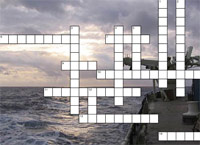|

 Today's Weather Mostly cloudy Lat: 04° 03’S Long: 12° 17’W Air Temp: 78.6°F Bar Pressure: 1008.4 mbar Sea Temp: 79.5°F Sea State: 5-7 ft Swell Height: <7 ft, SSE Wind: SSE; 13-16 knots Visibility: Unlimited
Try the new AUV Communications
Bits, Bytes, and Information Packets The hush in the lab tonight is a big change from the hustle and bustle of the last few days. While Jaguar approaches the seafloor on its first mission of the cruise, many members of the science party are taking the opportunity to catch some well-deserved ZZZ’s before they come back on watch again. During the day, the engineers decided to reverse the order of tasks that Jaguar will execute when it reaches the bottom. Because the length of the survey Jaguar can complete is determined by how long its battery power lasts, the team decided to first have Jaguar drop down to only 3 meters (10 feet) above the seafloor. There, it will collect digital images of the bottom along a line that cuts across the survey area. After that, Jaguar will ascend to 25 meters (82 feet) above the seafloor and swim a series of 17 lines that are each 650 meters (0.4 miles) long, collecting high-resolution sonar data to make a detailed map of the site. It is so far, so good. Jaguar is communicating with the engineers on the ship, and its navigation system using the seafloor transponders is working. But how do scientists and engineers “talk” to the AUVs when they are under water? Humans use the sound patterns of speech in order to communicate and interpret information. But inside AUVs, a computer circuit in its “brain” responds to sound wave patterns that it can interpret very simply as a rapid sequence of “on” and “off” states (represented by the digits “1” or “0”). Each tiny “on” or “off” part of the sound wave is called a “bit,” which is the fundamental unit of digital computing. The computers on the AUVs use a string of eight bits—called a byte—as the basic unit of information. In human language, a byte is similar to a letter, a number, or a symbol. Because there are 256 combinations of eight bits (each bit can be either a “1” or “0”), the computer has 256 bytes it can use to communicate. With all the things an AUV has to do, it has very little time to “talk” to the engineers and scientists on the Knorr. Therefore, roughly every two minutes it sends limited “information packets” composed of 32 bytes that include its position and data from its various sensors. It is as if the AUV “talks” in sentences that have only 32 letters. And the ship sends 32 byte information packets back to the AUV. If you tried to talk in sentences containing 32 letters, you might say (counting punctuation but not spaces): WITH A BYTE PER LETTER YOU CAN SAY THIS. That’s not much information! If you always spoke in 32-byte sentences, your language would sound pretty simple. But engineers organize information packets in such a way that they can communicate as much information as possible. The AUVs and the engineers use the same format to send information back and forth to each other again and again, so the structure of the information is always the same. This is the same as the way humans use mailing addresses, for example. We all live in different places, but we address our mail in a standard order and format that everyone understands. It is this language that allows computers and engineers to “talk”—as we are now talking to Jaguar about 3800 meters (2.4 miles) away at the bottom of the ocean. Read the interview Adam Seamans: Adam Seamans, who grew up in Beverly, MA, is the Chief Mate aboard the Knorr. He talks about his career path and job responsibilities—including advice to anyone interested in working on a ship at sea! Read the interview »
[ Previous day ] [ Next day ]
|
||
Mailing List | Feedback | Glossary | For Teachers | About Us | Contact
© 2010 Dive and Discover™. Dive and Discover™ is a registered trademark of Woods
Hole Oceanographic Institution




